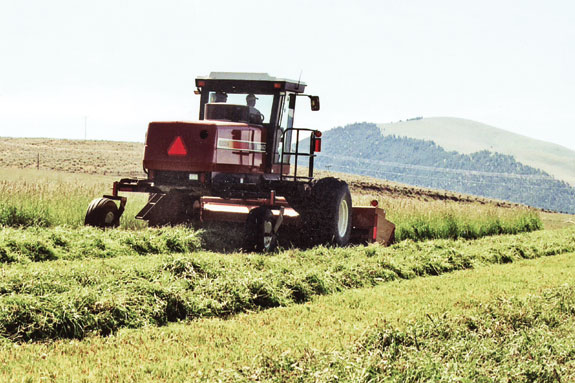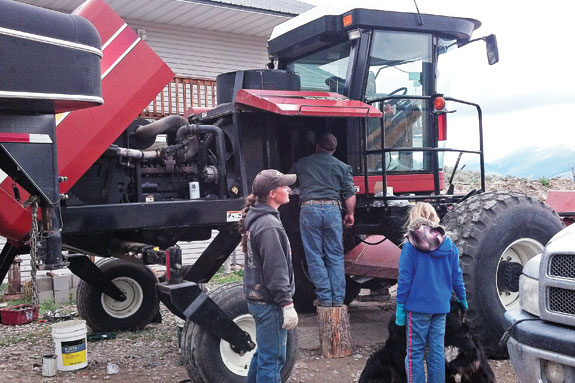Or your four-wheeler won’t start when you are fixing fence in the far pasture, and it’s a 2-mile hike home.
Being able to do basic repairs on the job – without having to haul your outfit to town or wait for a mechanic to schedule a farm call – can save time and money.
If you have the proper tools, you can take the broken piece apart (paying attention to what comes apart and where), put it together and not have a piece left over wondering where it should go.

Keeping directions
It helps to have an operator’s manual on every piece of machinery on your place, according to Michael Thomas, a rancher near Baker, Idaho.
“Even for some of the older equipment, the dealership can usually order one for you,” he says.
The operator's manuals contain maintenance and troubleshooting sections, but to really know what you are getting into before you start tearing the machine apart, you need the diagrams.
“Then you can get parts through the local supply store without having to try to describe the ‘thing-a-ma-widget that attaches to the thing-a-ma-bob;’ the catalog gives you the proper name and number of the piece you need,” Thomas says.

Working intricate pieces, such as a baler knotter or the knife drive in a windrower, requires some structure to your work.
If you're working in the dirt, rather than a concrete floor or shop and start disassembling components, it's helpful to lay each piece on a board in the order it is removed.
"Then after I get the worn-out component apart and replace it, I can go back in the proper order and reassemble it,” Thomas explains.
“When you get into a component with a dozen or more small parts that seem logical when you take them apart, you might forget the order after you’ve gone to town for the piece you need or after you waited a few days for an ordered part to come in. ... If you make a habit of laying things out in order, it eliminates guessing,” says Thomas.
“With most intricate components, do the reassembly with your operator’s manual in hand. Knife drives and baler knotters, for instance, have specific clearances, tensions and timing requirements.
Having the parts book or catalog for that particular machine will help also. If a component is worn-out or destroyed, or you weren’t careful keeping track of the order of parts as you removed them, the catalog has an expanded diagram.
You can see how it comes apart and goes together – and the order of pieces within that component,” he says.
For faulty pieces, use the part number when calling a dealership to reorder it. This saves time so the dealership doesn’t have to try to figure out what part you are talking about, Thomas says.
Timing it right
When using your operator’s manual for a swather, baler, combine, etc., you can see the various series of components that work in a certain relationship to one another.
“Timing of movement is crucial. If you have a problem with a baler, for instance, it’s important that you know which parts work in relationship to each other.
If you replace one piece within the series of inter-related parts, you need to follow the manual carefully to re-time or verify that you haven’t gotten the series out of time,” he says.
“With a baler, for example, the plunger cycle relationship to the needles, knotters and stuffer fingers all has to be just right.
On square balers – with the exception of the little in-line balers – all the balers that pick up a windrow and deliver the hay to the plunger from one side have a series of fingers that bring the hay across.
All of those components work in a very tight tolerance to one another. If you lose the proper cycle and the timing is off, the plunger might shear off the knotter needles or the stuffer fingers because it’s in the chamber at the wrong time,” Thomas explains.
“If you have to rebuild or repair any one of those components, when you put it all back together you must run the machine through the cycle by hand, using the manual to make sure the timing is right. Anyone is capable of re-timing a piece of equipment, if they are careful and follow the directions.”
It’s important to look over those sections of the manual. The difference between the knotter making a nice knot and tying a bale every time or missing one now and then is related to how the knotter is timed, along with the timing and tension of the needles to the knotter, and the tucker finger grabbing the twine and bringing it around.
“If you can re-set the timing after replacing a worn-out part on the knotter, you won’t be frustrated because the baler is still not tying,” he says.
Saving time and money
Don’t be afraid to tear into a piece of machinery. Once a person gains more confidence, it’s easier to continue learning, expanding your level of confidence and ability.
“If you have the manual, parts catalog and proper tools, you know what you’re going to see when you get into that machine. You know how everything works in relationship to the other parts,” he says.
Become intimately familiar with every machine, with regular maintenance, so you can fix most things that go wrong.
“There’s a certain level of maintenance required to keep from having breakdowns, and then you can expand your abilities to repairing things that wear out,” Thomas explains.
Ed Snook, who ranches near Tendoy, Idaho, says he tries to do oil changes in the spring and fall when the machinery isn’t in the field.
“Before haying I go through all the equipment and see if any parts need replaced,” he says.
If a person does repairs in the off season, there’s more opportunity for discounts on parts. “Many implement dealers and supply outfits have specials—maybe 10 percent off – if you order parts in January and February. They are trying to make some money during their slack time,” says Snook.
“I spend about $15,000 in repairs each year, so 10 percent is a big savings. You can’t save money every time; if you’re faced with a breakdown during haying you have to fix it immediately,” Snook says.
Simple prevention steps
Regular maintenance is crucial to reduce the frequency and seriousness of breakdowns.
Grease it as often as recommended in the manual, and make sure you find all the places that need serviced. “Many pieces of equipment have lubrication points that are not easy to see unless you know where to look.
As you become more familiar with the machine through the process of daily lubrication, this will help you be able to recognize a component that’s failing.,” Thomas says.
“Grease the individual components, check the gear box, lube levels, etc., and as you get to know the equipment, you will begin to understand the relationships involving how the parts work and synchronize with each other.
Then when it comes to more serious maintenance, you will more quickly recognize where a problem is,” he says.
Snook adds that with operations that have a variety of hired help, it's critical to communicate about machinery needing maintenance.
You need to be able to recognize a change in how it is running. “It may have a new knocking, rattle or squeak, or maybe it didn’t have grease or oil in that spot, and you realize a seal has failed.
Usually problems start small and get big in a hurry if you don’t stop the machine. If one component fails, it impacts the others.
Many machines have safety devices so that if one part fails, it will shut down the operation before it destroys more parts and creates a major breakdown,” Thomas explains. ![]()
Heather Smith Thomas is a freelance writer based in Idaho.
PHOTOS
TOP RIGHT: A baler is an example of equipment with components working in tight tolerance with another.
MIDDLE RIGHT: Knowing your equipment makes a difference in helping detect small fixes that need attention.
BOTTOM RIGHT: Michael Thomas does maintenance repairs on his swather. Photos by Heather Thomas
Repairs for the four-wheeler
Nearly every farm or ranch today uses all-terrain vehicles for transport to and from the fields, packing tools and material for fixing fence, hauling salt, moving cattle, etc.
“Most four-wheelers have a toolbox, and it’s a good idea to have a spare spark plug in there and a wrench kit. Make sure it has a spark plug wrench, pliers and a basic hand-wrench set.
Most of them are metric today – make sure you have the wrenches you might need,” says Michael Thomas.
Failure to start may be as simple as battery hookups working loose or a bad spark plug. “If the four-wheeler quits, and it’s a spark plug issue, you can pull the old one out and put in a new one.
“Most carburetor problems can be fixed out in the field with the wrenches that come with the machine. If there’s water in the fuel, and you have the proper screwdriver, you can drain the sediment bowl and let the water out. You might have to do it three or four times to get home, but you can usually manage,” he says.
“Another thing that’s handy for a four-wheeler is a tire-plug kit. This is also handy for larger equipment if you have a flat tire. It’s not uncommon to run a nail or sharp stick through a tire.
Swather and combine tires are notorious for weather checking or cracks and having straw stubble work up into the tire. You can put a plug in the tire and fix the hole.”
Build your toolbox
You’ll need the proper tools for various jobs, and as you get more proficient at repairs – able to tackle more complicated challenges – you may need a few more tools.
- End wrenches (up to 1½ inches in a standard set, and up to 35 mm metric)
- Socket wrenches (up to 1½ inches in a standard set, and up to 35 mm metric)
- Drill and bits to drill out broken bolts
- Punches and chisels
- Small- to medium-size vice
- Sandpaper and emery cloth for replacing bearings
- Mallets or a small sledgehammer
- A portable air compressor for blowing out radiators, air filters, air-impact wrenches, or flat tires
Other items:
- A cutting torch and welder is a good option for those with advanced mechanical skills, especially when removing a bearing off a shaft
- A torque wrench, spring scale, micrometer provide accurate measurement for intricate pieces that require you to measure distances in very small increments, such as one-thousandth of an inch








